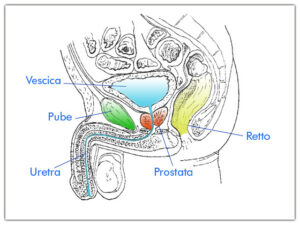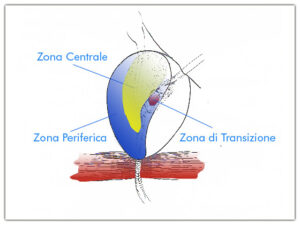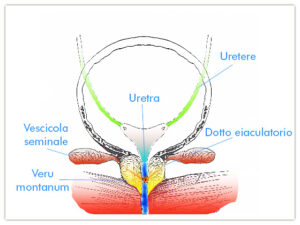
Macroscopic Anatomy of the Prostate
In shape the prostate is usually described as a flattened cone with the base upwards,the apex downwards and four sides with rounded corners.
The four sides are known as the front, back and lower-lateral faces. A normal prostate is 4 cm in length, 3 cm at the cross-section and 2.5 cm at the antero-posterior section. Weight ranges from 15 to 20 gr.
Lodged in the pelvis, the prostate adheres strongly to the bladder neck and is fixed to the pelvic bones (mainly anteriorly to the pubis) by many ligaments and other supporting structures e.g. the urogenital diaphragm
Microscopic Anatomy of the Prostate

Thirty percent of the prostate is muscle fibre and the remaining seventy percent is made up of glandular cells grouped together in about 30 glandular units known as acina.
The prostate can be divided into three zones: the peripheral(PZ), the central(CZ) and the periurethral transitional area(TZ)
This subdivision is extremely important as prostate tumors almost always originate in the peripheral zone and BPH in the transitional. Depending on its causes, prostatitis originates in the periurethral or peripheral zones and causes different symptoms in each instance.
Ducts

The prostate contains three large ducts, a small central duct known as the utriculus and as many small canals as there are acina.
The three major ducts are:
- in the middle the urethra through which urine flows from the bladder;
- to the right and left of the urethra, the ejaculatory ducts which join the urethra at the veru montanum and through which sperm pass from the deferential ampullas.
The utriculus is a small duct which joins the veru montanum between the two ejaculatory ducts. It is considered a pre-sex differentiation embryological remnant of what will become the uterus in females. After birth, in males the utriculus may atrophy and almost totally disappear or become a closed duct, dilate and form cysts ((utricular cysts) which may cause prostatitis-like symptoms if inflamed.
During ejaculation, the fluid produced by each acinus flows through the minor ducts (which also join the urethra at the veru montanum) to mix with the sperm from the seminal vesicles. This prostatic fluid is essential to ensure motility and vitality of spermatozoa and indeed, in the course of prostate inflammation, abnormalities in them may impair fertility.
Seminal vesicles and baldder neck
A description of the prostate anatomy would be seriously incomplete without a mentioning the deferential ampullas, the seminal vesicles and the bladder neck. Although they are not a part of the prostate, these organs play an essential role in its functioning.
The deferential ampullas contain the sperm produced by the testicles.
The seminal vesicles, as the name suggests, are two small, internally pluriseptate sacs (mean diameter 5×4 cm) which only help in the physiological semen chemical composition. The strong pelvic muscles contraction during orgasm, force the semen into the ejaculatory ducts which join the urethra, where it is mixed with the prostatic fluid secreted by the acini, before being ejaculated.
The bladder neck is the area at the base of the bladder which opens into a funnel during micturition to allow urine to flow along the lines of less resistance, in the proximal urethra. The urethra distends when urine is passing and when is pulled by specific extra-urethral muscles.
From the above description we can now provide an answer to a common question:
“What is the prostate for?”
The prostate function is to produce and store in its glandular acini the prostatic fluid, , for nourishing the spermatozoa in the sperm, which is stored in the deferential ampullas. During orgasm the pelvic muscles force both prostatic fluid and sperm into the urethra at the same time. There they are mixed and ejaculated.

